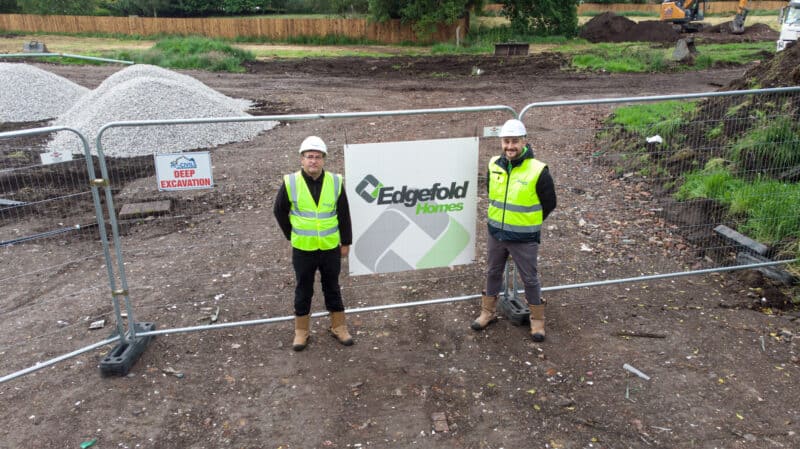
The planning challenges facing SME housebuilders:
The critical role of SME housebuilders in delivering our nation’s housing.
The UK is suffering from a housing crisis that has been 30 years in the making. According to Shelter, it affects around one in three adults in Britain and leaves over 1.6m households on the waiting list for social housing.
The government has committed to increasing building output to deliver 300,000 homes in England each year and we couldn’t need it more.
Yet in 2020/21, according to the House of Lords Built Environment Committee’s Meeting Housing Demand report, large housebuilders only delivered 172,000 new homes between them. The picture is even bleaker for SMEs: their contribution was 22,060, just 11% of the total pot.
If we are to get close to the 300,000 target, we can’t rely purely on the big housebuilders. We need to support and enable SMEs as well.
Small housebuilders are vital to building the homes this country needs but too often struggle to access affordable finance.
Robert Jenrick, speaking in January 2020 as SoS for MHCLG
SMEs face some serious hurdles in the housebuilding race, and are responsible for delivering a dwindling proportion of England’s new homes – down from 40% in 1988 to only 10% now. In order to support these essential local employers and encourage diversity in the market, the government has established £1 billion of finance through its ENABLE Build Programme.
However, finance is only one of the hurdles that can topple a SME housebuilder in this complex market. A lack of available viable land, material shortages and the planning system are just as likely to upend a smaller firm’s plans.
Whilst we at P4 Planning can’t do much about the availability of land or the rising cost of materials, we can call for a more common sense approach to be applied to the planning system.
We spoke to our client and SME housebuilder Edgefold Homes to understand the team’s experiences as they seek to deliver much-needed new housing.
Ken Whitaker, Jack, and Billy Seddon reflected on some of the challenges they faced navigating the planning system recently, and what could make things easier for SME housebuilders.

WHY IS NAVIGATING THE PLANNING SYSTEM MORE DIFFICULT FOR SME HOUSEBUILDERS?
In a nutshell, a smaller housebuilder faces disproportionate costs, risks and burdens compared to a larger housebuilder. SME schemes can be subject to the same delays, but the implications of delay can be far greater.
DISPROPORTIONATE COSTS UPFRONT
Any planning application – whether for 10 houses or 200 – needs the same technical assessments to check ground conditions, ecological value, trees, and so on.
An SME housebuilder may take 20 sites to deliver 200 homes, whereas a larger builder will often deliver the same on one. For the larger housebuilder, that’s one planning statement, one ground conditions report, one ecological survey, etc. For the SME, that’s 20 of each report and 20 applications.
As an SME, you’re in the planning system more, with its inherent uncertainties and upfront costs. In simple economic terms, it costs us more.
DISPROPORTIONATE PLANNING HURDLES
Small sites are just as likely as large sites to have sensitive planning, landscape or ecological impacts that require expert negotiation. There’s no guarantee that an application for a smaller housing scheme will move through the planning system any quicker than a larger one; in fact they often take longer because they are windfall rather than allocated sites in a development plan.
Edgefold’s site at Dunham Massey is a great example. It required extensive negotiation to persuade the council that the proposal did not comprise ‘inappropriate development’ in the Green Belt.
Large allocated sites usually experience a smoother run. Not just because the principle of housing has already been established, but because when extensive consultation on a strategic site has taken place already, there tends to be less local opposition and less political lobbying.
DISPROPORTIONATE DESIGN NEGOTIATIONS
Local planning authorities (LPAs) often expect bespoke designs from SME housebuilders. After all, it’s not a national housebuilder with nationwide design codes that must be stuck to, right?
Or, sometimes, it’s simply that SMEs are more willing to take on design changes because they are more invested in the region.
However, changes can lead to design by committee, bringing added costs and delays that have the potential to make a marginal site unviable: every extra cost takes funds directly from the project itself.
At Dunham, we appointed a high quality architect to come up with a thoughtful scheme that reflected the character of a local rural farmstead. But, the local parish councils had differing views and the planning officer wanted a redesign. We’ve ended up with a totally different look, added costs and a less deliverable scheme than the original plan. Nobody wins.
DISPROPORTIONATE REQUIREMENTS
Every year brings more bureaucracy and hurdles to overcome. Increased requirements on developers – like the recent changes to biodiversity net gain, nitrate neutrality or the House of Commons recommendation to introduce whole-life carbon assessments for buildings – are part of the bigger conversation about addressing climate change. And yet, these changes put disproportionate weight on the SME housebuilder that lacks the economies of scale to easily address these issues.
Whilst a large housing site may have land set aside for SuDS and biodiversity net gain, a small site might have to lose a valuable housing plot in order to meet those requirements.
DISPROPORTIONATE RISKS ARISING FROM DELAYS
If you have multiple active sites across the UK, you can redistribute your workforce and progress another project if one gets delayed in the planning system.
However, any delay to an SME’s project, when that firm only has a couple of active sites, will have far bigger implications.
Uncertain timescales and unknown costs make it impossible to run a steady business. SME housebuilders find themselves pushed towards using contracted, rather than employed, staff so exacerbating local economic uncertainty.
We need more certainty of timeframe to be able to maintain teams and a continuity of work. We’d love to employ more apprentices but with such uncertain planning timeframes, the risks are far too high.
HOW CAN THE PLANNING SYSTEM BETTER SUPPORT SME HOUSEBUILDERS?
It can feel like the planning system is set up to work against SMEs. Businesses like Edgefold are incentivised to move away from small sites and focus their efforts on bigger, more profitable schemes.
But, we need SMEs to help achieve our housing targets and deliver a more diverse and stronger housing supply.
Homes England’s Housing Growth Partnership is a step in the right direction, but else what can be done?

GREATER SUPPORT TO HELP SMES ACQUIRE STRATEGIC SITES
SMEs like Edgefold Homes almost always promote windfall sites through the planning system. That’s because larger allocated sites get snapped up by bigger housebuilders who are more able to out-bid smaller firms in a competitive scenario, and make an investment with a decade-long horizon.
Earmarking a certain proportion of allocated housing for local SMEs would help reduce the planning risk.
Promoting an allocated site would take out the main area of risk for SMEs like us. And that would help bring certainty and continuity.
MAKE ALLOWANCES FOR SMALL SITES
Measures such as biodiversity net gain are valuable and crucial to addressing the climate crisis. But perhaps a level of realism is needed for smaller sites that are already finely balanced in viability terms.
Allowances should be made to protect small sites from onerous requirements that are simply not always achievable.
In August 2020, the Government consulted on proposals to extend the small sites threshold to up to 40 or 50 units to support SME builders by lifting onerous s106 burdens. However, it has now decided not to raise the threshold at this stage.
We believe that this measure would make a tangible difference and is urgently needed to support SMEs.
STOP CHANGING THINGS…
Each time planning or building regulations are changed, it adds another layer of complexity. SME housebuilders have fewer in-house resources than larger housebuilders to decipher the changes and implications for their business.
It inevitably brings in delays and potentially abortive work when the standards of design and construction become a moving target.
BRING MORE COMMON SENSE TO THE TABLE
Planning officers and developers should operate from a position of ‘how can we work together to achieve this?’ A more collaborative approach to using the planning system most effectively would benefit everyone.
So how could this approach help SMEs specifically?
FEWER PLANNING CONDITIONS
We need to get away from the automatic position of adding so many conditions to every consent. For example, the appropriate design of a boundary fence shouldn’t always need officer sign off.
The process of discharging critical pre-start conditions is often almost as lengthy as the main application itself. That’s partly because officers, understandably, are overworked, teams are underresourced and condition discharge is not prioritised.
But it’s also because of a gap in commercial understanding about the impact of delays on the running of SME businesses. Early and efficient condition discharge is absolutely vital to minimise delays.
MORE TIME FOR MATTERS OF PRINCIPLE
With fewer conditions, officers should be freed up, allowing them more time for quality negotiations with applicants and address critical planning matters more efficiently.
This would bring more certainty to SMEs as to when their application would receive quality feedback and when it will be determined.
SMEs like Edgefold Homes operate with a positive mindset and are motivated to maintain a can-do approach to house building. But, they need the support of decision-makers to minimise uncertainties and unecessary hurdles so they can carry on doing what they do best.
Dunham has been a good outcome, but for a while the application could have gone either way. Over the two years it’s taken to navigate the planning system, the housing market has moved on and is now less certain. And with central government in a seemingly perpetual state of flux, its hard to see when ministers will have the time to focus on these critical issues to give SMEs the certainty they need to navigate the planning system.
Get in touch with P4 Planning if you have a site that is facing difficulty navigating the planning system. We’d love to help.